Ultra Long Period Cepheids: Observation and Theory
Abstract
:1. Introduction
2. Literature Samples
3. ULPs as Distance Indicators
4. ULP Evolutionary Phase
5. Comparison with Theoretical Models
6. Discussion
Funding
Institutional Review Board Statement
Informed Consent Statement
Data Availability Statement
Conflicts of Interest
References
- Freedman, W.L.; Madore, B.F.; Gibson, B.K.; Ferrarese, L.; Kelson, D.D.; Sakai, S.; Mould, J.R.; Kennicutt, R.C., Jr.; Ford, H.C.; Graham, J.A.; et al. Final Results from the Hubble Space Telescope Key Project to Measure the Hubble Constant. Astrophys. J. 2001, 553, 47–72. [Google Scholar] [CrossRef]
- Altavilla, G.; Fiorentino, G.; Marconi, M.; Musella, I.; Cappellaro, E.; Barbon, R.; Benetti, S.; Pastorello, A.; Riello, M.; Turatto, M.; et al. Cepheid calibration of Type Ia supernovae and the Hubble constant. Mon. Not. R. Astron. Soc. 2004, 349, 1344–1352. [Google Scholar] [CrossRef]
- Di Criscienzo, M.; Caputo, F.; Marconi, M.; Musella, I. RR Lyrae-based calibration of the Globular Cluster Luminosity Function. Mon. Not. R. Astron. Soc. 2006, 365, 1357–1366. [Google Scholar] [CrossRef] [Green Version]
- De Somma, G.; Marconi, M.; Molinaro, R.; Cignoni, M.; Musella, I.; Ripepi, V. An Extended Theoretical Scenario for Classical Cepheids. I. Modeling Galactic Cepheids in the Gaia Photometric System. Astrophys. J. Suppl. Ser. 2020, 247, 30. [Google Scholar] [CrossRef] [Green Version]
- Riess, A.G.; Macri, L.; Casertano, S.; Lampeitl, H.; Ferguson, H.C.; Filippenko, A.V.; Jha, S.W.; Li, W.; Chornock, R. A 3% Solution: Determination of the Hubble Constant with the Hubble Space Telescope and Wide Field Camera 3. Astrophys. J. 2011, 730, 119. [Google Scholar] [CrossRef] [Green Version]
- Fiorentino, G.; Annibali, F.; Clementini, G.; Ramos, R.C.; Marconi, M.; Musella, I.; Saha, A.; Tosi, M.; Aloisi, A.; van der Marel, R. Ultralong-period Cepheids: A possible primary distance indicator? In Advancing the Physics of Cosmic Distances; de Grijs, R., Ed.; IAU Symposium: Paris, France, 2013; Volume 289, pp. 282–286. [Google Scholar]
- Anderson, R.I.; Riess, A.G. On Cepheid Distance Scale Bias Due to Stellar Companions and Cluster Populations. Astrophys. J. 2018, 861, 36. [Google Scholar] [CrossRef]
- Verde, L.; Treu, T.; Riess, A.G. Tensions between the early and late Universe. Nat. Astron. 2019, 3, 891–895. [Google Scholar] [CrossRef]
- Bird, J.C.; Stanek, K.Z.; Prieto, J.L. Using Ultra Long Period Cepheids to Extend the Cosmic Distance Ladder to 100 Mpc and Beyond. Astrophys. J. 2009, 695, 874–882. [Google Scholar] [CrossRef] [Green Version]
- Fiorentino, G.; Clementini, G.; Marconi, M.; Musella, I.; Saha, A.; Tosi, M.; Contreras Ramos, R.; Annibali, F.; Aloisi, A.; van der Marel, R. Ultra long period Cepheids: A primary standard candle out to the Hubble flow. Astrophys. Space Sci. 2012, 341, 143–150. [Google Scholar] [CrossRef] [Green Version]
- Gerke, J.R.; Kochanek, C.S.; Prieto, J.L.; Stanek, K.Z.; Macri, L.M. A Study of Cepheids in M81 with the Large Binocular Telescope (Efficiently Calibrated with Hubble Space Telescope). Astrophys. J. 2011, 743, 176. [Google Scholar] [CrossRef] [Green Version]
- Fiorentino, G.; Marconi, M.; Musella, I.; Caputo, F. Classical Cepheid pulsation models. XI. Effects of convection and chemical composition on the period-luminosity and period-Wesenheit relations. Astron. Astrophys. 2007, 476, 863–879. [Google Scholar] [CrossRef] [Green Version]
- Bono, G.; Caputo, F.; Fiorentino, G.; Marconi, M.; Musella, I. Cepheids in External Galaxies. I. The Maser-Host Galaxy NGC 4258 and the Metallicity Dependence of Period-Luminosity and Period-Wesenheit Relations. Astrophys. J. 2008, 684, 102–117. [Google Scholar] [CrossRef] [Green Version]
- Fiorentino, G.; Contreras Ramos, R.; Clementini, G.; Marconi, M.; Musella, I.; Aloisi, A.; Annibali, F.; Saha, A.; Tosi, M.; van der Marel, R.P. Multi-Epoch Hubble Space Telescope Observations of IZw18: Characterization of Variable Stars at Ultra-Low Metallicities. Astrophys. J. 2010, 711, 808–817. [Google Scholar] [CrossRef] [Green Version]
- Marconi, M.; Musella, I.; Fiorentino, G.; Clementini, G.; Aloisi, A.; Annibali, F.; Contreras Ramos, R.; Saha, A.; Tosi, M.; van der Marel, R.P. Pulsation Models for Ultra-low (Z = 0.0004) Metallicity Classical Cepheids. Astrophys. J. 2010, 713, 615–625. [Google Scholar] [CrossRef] [Green Version]
- Riess, A.G.; Macri, L.M.; Hoffmann, S.L.; Scolnic, D.; Casertano, S.; Filippenko, A.V.; Tucker, B.E.; Reid, M.J.; Jones, D.O.; Silverman, J.M.; et al. A 2.4% Determination of the Local Value of the Hubble Constant. Astrophys. J. 2016, 826, 56. [Google Scholar] [CrossRef]
- Hoffmann, S.L.; Macri, L.M.; Riess, A.G.; Yuan, W.; Casertano, S.; Foley, R.J.; Filippenko, A.V.; Tucker, B.E.; Chornock, R.; Silverman, J.M.; et al. Optical Identification of Cepheids in 19 Host Galaxies of Type Ia Supernovae and NGC 4258 with the Hubble Space Telescope. Astrophys. J. 2016, 830, 10. [Google Scholar] [CrossRef] [Green Version]
- Ngeow, C.C.; Lee, C.H.; Yang, M.T.C.; Lin, C.S.; Hsiao, H.Y.; Cheng, Y.C.; Lin, Z.Y.; Lin, I.L.; Kanbur, S.M.; Ip, W.H. VI-Band Follow-Up Observations of Ultra-Long-Period Cepheid Candidates in M31. Astron. J. 2015, 149, 66. [Google Scholar] [CrossRef] [Green Version]
- Taneva, N.; Valcheva, A.; Petrov, G.P.; Nedialkov, P. Ultra long period Cepheid H 42 in M 31. Bulg. Astron. J. 2020, 33, 75. [Google Scholar]
- Musella, I.; Marconi, M.; Molinaro, R.; Fiorentino, G.; Ripepi, V.; De Somma, G.; Moretti, M.I. New insights into the use of Ultra Long Period Cepheids as cosmological standard candles. Mon. Not. R. Astron. Soc. 2021, 501, 866–874. [Google Scholar] [CrossRef]
- Soszyński, I.; Udalski, A.; Szymański, M.K.; Skowron, D.; Pietrzyński, G.; Poleski, R.; Pietrukowicz, P.; Skowron, J.; Mróz, P.; Kozłowski, S.; et al. The OGLE Collection of Variable Stars. Classical Cepheids in the Magellanic System. Acta Astron. 2015, 65, 297–312. [Google Scholar]
- Pellerin, A.; Macri, L.M. The M 33 Synoptic Stellar Survey. I. Cepheid Variables. Astrophys. J. Suppl. Ser. 2011, 193, 26. [Google Scholar] [CrossRef] [Green Version]
- Kodric, M.; Riffeser, A.; Hopp, U.; Goessl, C.; Seitz, S.; Bender, R.; Koppenhoefer, J.; Obermeier, C.; Snigula, J.; Lee, C.H.; et al. Cepheids in M31: The PAndromeda Cepheid Sample. Astron. J. 2018, 156, 130. [Google Scholar] [CrossRef]
- Yuan, W.; Fausnaugh, M.M.; Hoffmann, S.L.; Macri, L.M.; Peterson, B.M.; Riess, A.G.; Bentz, M.C.; Brown, J.S.; Bontà, E.D.; Davies, R.I.; et al. The Cepheid Distance to the Seyfert 1 Galaxy NGC 4151. Astrophys. J. 2020, 902, 26. [Google Scholar] [CrossRef]
- Bentz, M.C.; Ferrarese, L.; Onken, C.A.; Peterson, B.M.; Valluri, M. A Cepheid-based Distance to the Seyfert Galaxy NGC 6814. Astrophys. J. 2019, 885, 161. [Google Scholar] [CrossRef] [Green Version]
- Tonry, J.L.; Stubbs, C.W.; Lykke, K.R.; Doherty, P.; Shivvers, I.S.; Burgett, W.S.; Chambers, K.C.; Hodapp, K.W.; Kaiser, N.; Kudritzki, R.P.; et al. The Pan-STARRS1 Photometric System. Astrophys. J. 2012, 750, 99. [Google Scholar] [CrossRef] [Green Version]
- Harris, W.E. Transformation of HST WFC3/UVIS Filters to the Standard BVI System. Astrophys. J. 2018, 156, 296. [Google Scholar] [CrossRef]
- Landolt, A.U. UBVRI Photometric Standard Stars in the Magnitude Range 11.5 < V < 16.0 Around the Celestial Equator. Astrophys. J. 1992, 104, 340. [Google Scholar]
- Musella, I.; Di Criscienzo, M.; Marconi, M.; Raimondo, G.; Ripepi, V.; Cignoni, M.; Bono, G.; Brocato, E.; Dall’Ora, M.; Ferraro, I.; et al. The STREGA survey—II. Globular cluster Palomar 12. Mon. Not. R. Astron. Soc. 2018, 473, 3062–3071. [Google Scholar] [CrossRef] [Green Version]
- Musella, I.; Di Criscienzo, M.; Marconi, M.; Raimondo, G.; Ripepi, V.; Cignoni, M.; Bono, G.; Brocato, E.; Dall’Ora, M.; Ferraro, I.; et al. Erratum: The STREGA survey—II. Globular cluster Palomar 12. Mon. Not. R. Astron. Soc. 2021, 502, 3964. [Google Scholar] [CrossRef]
- de Grijs, R.; Bono, G. Clustering of Local Group Distances: Publication Bias or Correlated Measurements? II. M31 and Beyond. Astrophys. J. 2014, 148, 17. [Google Scholar] [CrossRef] [Green Version]
- Lee, C.H.; Ngeow, C.C.; Yang, M.T.C.; Ip, W.H.; Kwok-Hing Kong, A.; Laher, R.R.; Surace, J. Using the Palomar Transient Factory to Search for Ultra-Long-Period Cepheid Candidates in M31. arXiv 2013, arXiv:1309.5127. [Google Scholar]
- Gregersen, D.; Seth, A.C.; Williams, B.F.; Lang, D.; Dalcanton, J.J.; Girardi, L.; Skillman, E.D.; Bell, E.; Dolphin, A.E.; Fouesneau, M.; et al. Panchromatic Hubble Andromeda Treasury. XII. Mapping Stellar Metallicity Distributions in M31. Astrophys. J. 2015, 150, 189. [Google Scholar] [CrossRef]
- Ryder, S.D.; Fenner, Y.; Gibson, B.K. Stellar abundance gradients in galactic discs—I. Method and spectral line gradients. Mon. Not. R. Astron. Soc. 2005, 358, 1337–1351. [Google Scholar] [CrossRef] [Green Version]
- Schlafly, E.F.; Finkbeiner, D.P. Measuring Reddening with Sloan Digital Sky Survey Stellar Spectra and Recalibrating SFD. Astrophys. J. 2011, 737, 103. [Google Scholar] [CrossRef]
- Mortsell, E.; Goobar, A.; Johansson, J.; Dhawan, S. Sensitivity of the Hubble Constant Determination to Cepheid Calibration. arXiv 2021, arXiv:2105.11461. [Google Scholar]
- Perivolaropoulos, L.; Skara, F. Hubble tension or a transition of the Cepheid SnIa calibrator parameters? Phys. Rev. D 2021, 104, 123511. [Google Scholar] [CrossRef]
- Lardo, C.; Davies, B.; Kudritzki, R.P.; Gazak, J.Z.; Evans, C.J.; Patrick, L.R.; Bergemann, M.; Plez, B. Red Supergiants as Cosmic Abundance Probes: The First Direct Metallicity Determination of NGC 4038 in the Antennae. Astrophys. J. 2015, 812, 160. [Google Scholar] [CrossRef]
- Bressan, A.; Marigo, P.; Girardi, L.; Salasnich, B.; Dal Cero, C.; Rubele, S.; Nanni, A. PARSEC: Stellar tracks and isochrones with the PAdova and TRieste Stellar Evolution Code. Mon. Not. R. Astron. Soc. 2012, 427, 127–145. [Google Scholar] [CrossRef] [Green Version]
- Chen, Y.; Girardi, L.; Fu, X.; Bressan, A.; Aringer, B.; Dal Tio, P.; Pastorelli, G.; Marigo, P.; Costa, G.; Zhang, X. YBC: A stellar bolometric corrections database with variable extinction coefficients. Application to PARSEC isochrones. Astron. Astrophys. 2019, 632, A105. [Google Scholar] [CrossRef]
- Caputo, F.; Marconi, M.; Musella, I. Theoretical models for classical Cepheids. V. Multiwavelength relations. Astron. Astrophys. 2000, 354, 610–620. [Google Scholar]
- Marconi, M.; Musella, I.; Fiorentino, G. Cepheid Pulsation Models at Varying Metallicity and ΔY/ΔZ. Astrophys. J. 2005, 632, 590–610. [Google Scholar] [CrossRef] [Green Version]
- Fiorentino, G.; Caputo, F.; Marconi, M.; Musella, I. Theoretical Models for Classical Cepheids. VIII. Effects of Helium and Heavy-Element Abundance on the Cepheid Distance Scale. Astrophys. J. 2002, 576, 402–412. [Google Scholar] [CrossRef]
- Natale, G.; Marconi, M.; Bono, G. Theoretical Fits of the δ Cephei Light, Radius, and Radial Velocity Curves. Astrophys. J. Lett. 2008, 674, L93. [Google Scholar] [CrossRef]
- Marconi, M.; Molinaro, R.; Ripepi, V.; Cioni, M.R.L.; Clementini, G.; Moretti, M.I.; Ragosta, F.; de Grijs, R.; Groenewegen, M.A.T.; Ivanov, V.D. The VMC survey—XXIII. Model fitting of light and radial velocity curves of Small Magellanic Cloud classical Cepheids. Mon. Not. R. Astron. Soc. 2017, 466, 3206–3216. [Google Scholar] [CrossRef] [Green Version]
- Marconi, M.; Molinaro, R.; Ripepi, V.; Musella, I.; Brocato, E. Theoretical fit of Cepheid light a radial velocity curves in the Large Magellanic Cloud cluster NGC 1866. Mon. Not. R. Astron. Soc. 2013, 428, 2185–2197. [Google Scholar] [CrossRef] [Green Version]
- Ragosta, F.; Marconi, M.; Molinaro, R.; Ripepi, V.; Cioni, M.R.L.; Moretti, M.I.; Groenewegen, M.A.T.; Choudhury, S.; de Grijs, R.; van Loon, J.T.; et al. The VMC survey—XXXV. model fitting of LMC Cepheid light curves. Mon. Not. R. Astron. Soc. 2019, 490, 4975–4984. [Google Scholar] [CrossRef] [Green Version]
- Aloisi, A.; Clementini, G.; Tosi, M.; Annibali, F.; Contreras, R.; Fiorentino, G.; Mack, J.; Marconi, M.; Musella, I.; Saha, A.; et al. I Zw 18 Revisited with HST ACS and Cepheids: New Distance and Age. Astrophys. J. Lett. 2007, 667, L151–L154. [Google Scholar] [CrossRef] [Green Version]
- Wagner-Kaiser, R.; Sarajedini, A.; Dalcanton, J.J.; Williams, B.F.; Dolphin, A. Panchromatic Hubble Andromeda Treasury XIII: The Cepheid period-luminosity relation in M31. Mon. Not. R. Astron. Soc. 2015, 451, 724–738. [Google Scholar] [CrossRef] [Green Version]
- Ivezić, Ž.; Kahn, S.M.; Tyson, J.A.; Abel, B.; Acosta, E.; Allsman, R.; Alonso, D.; AlSayyad, Y.; Anderson, S.F.; Andrew, J.; et al. LSST: From Science Drivers to Reference Design and Anticipated Data Products. Astrophys. J. 2019, 873, 111. [Google Scholar] [CrossRef]
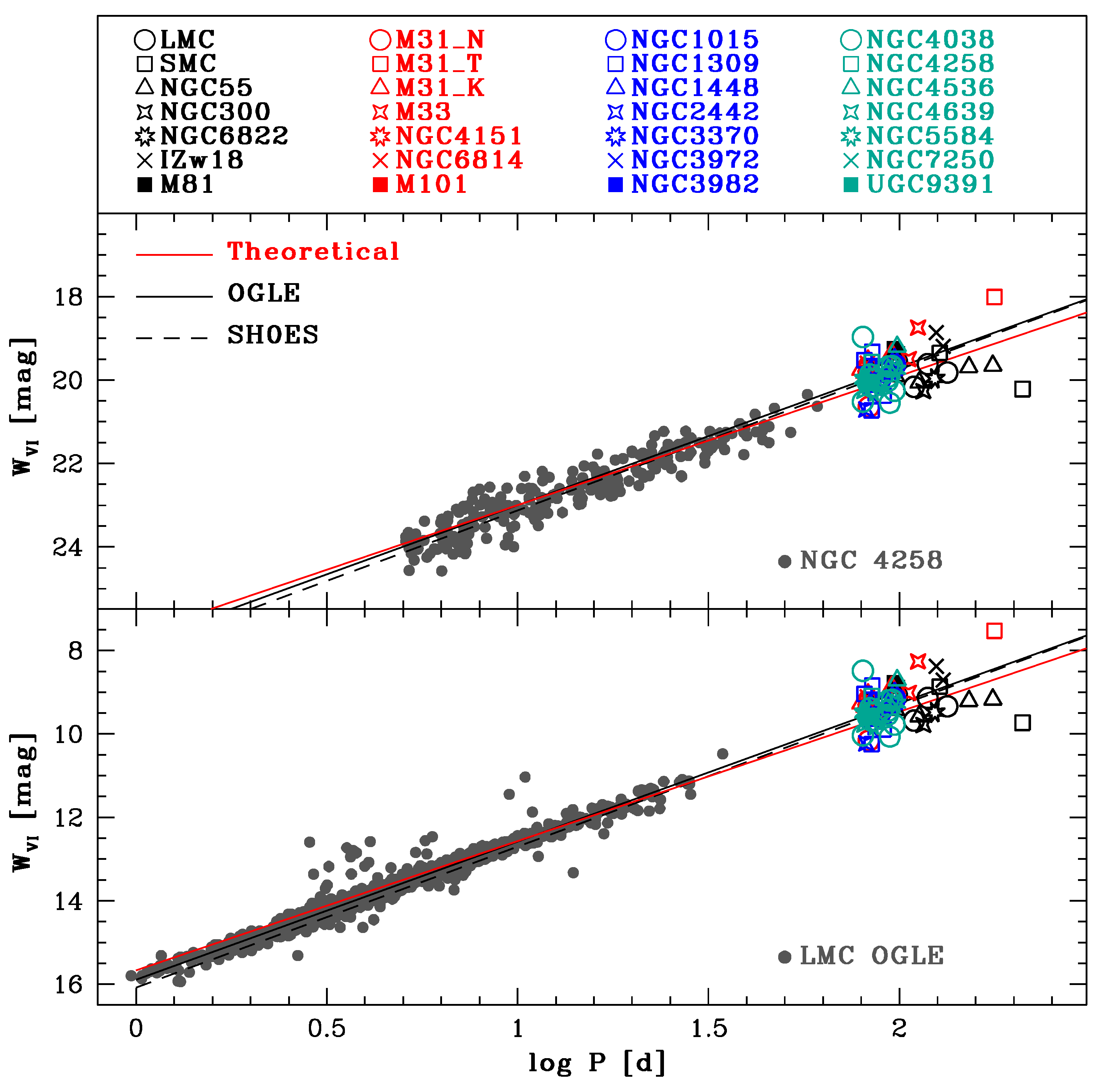
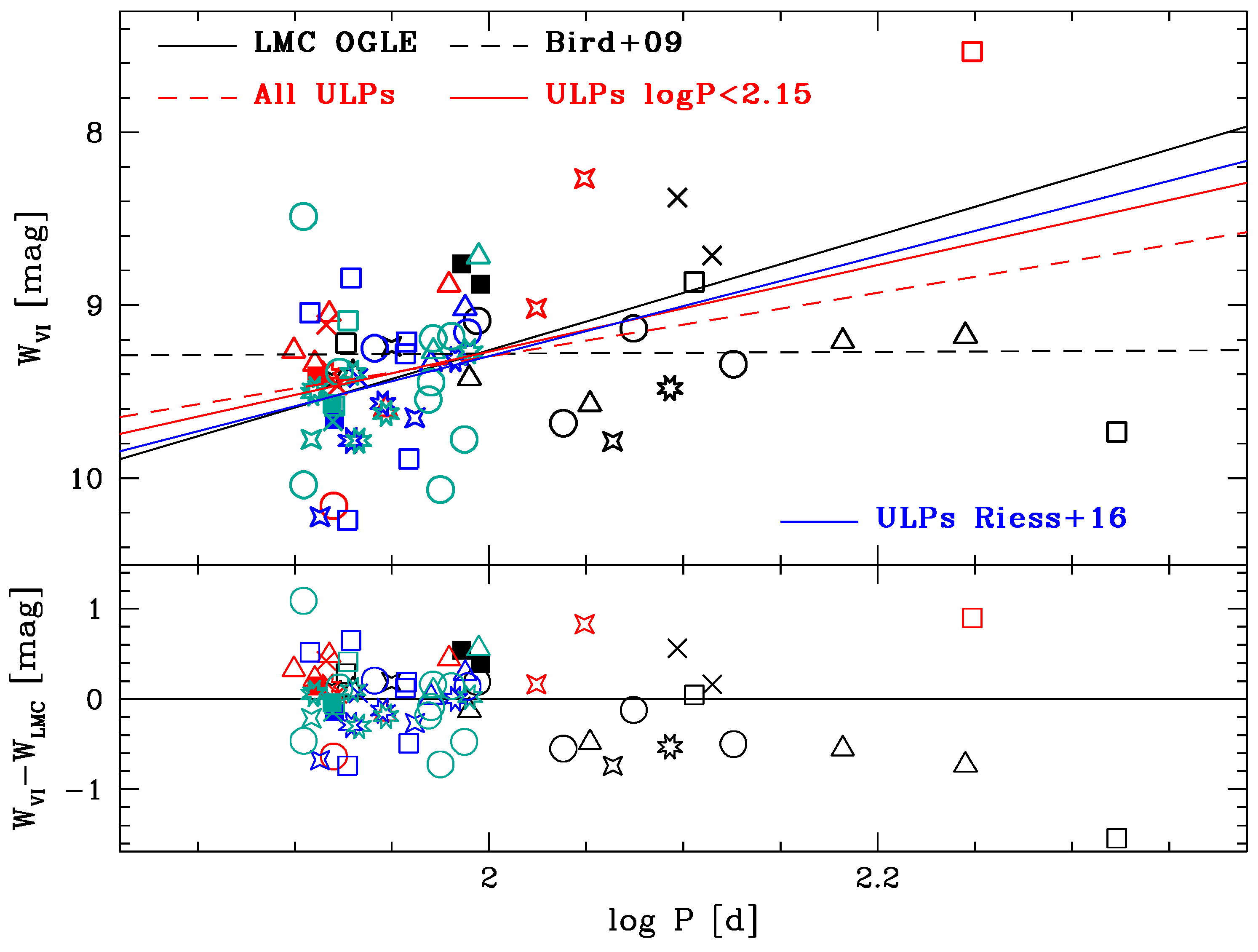

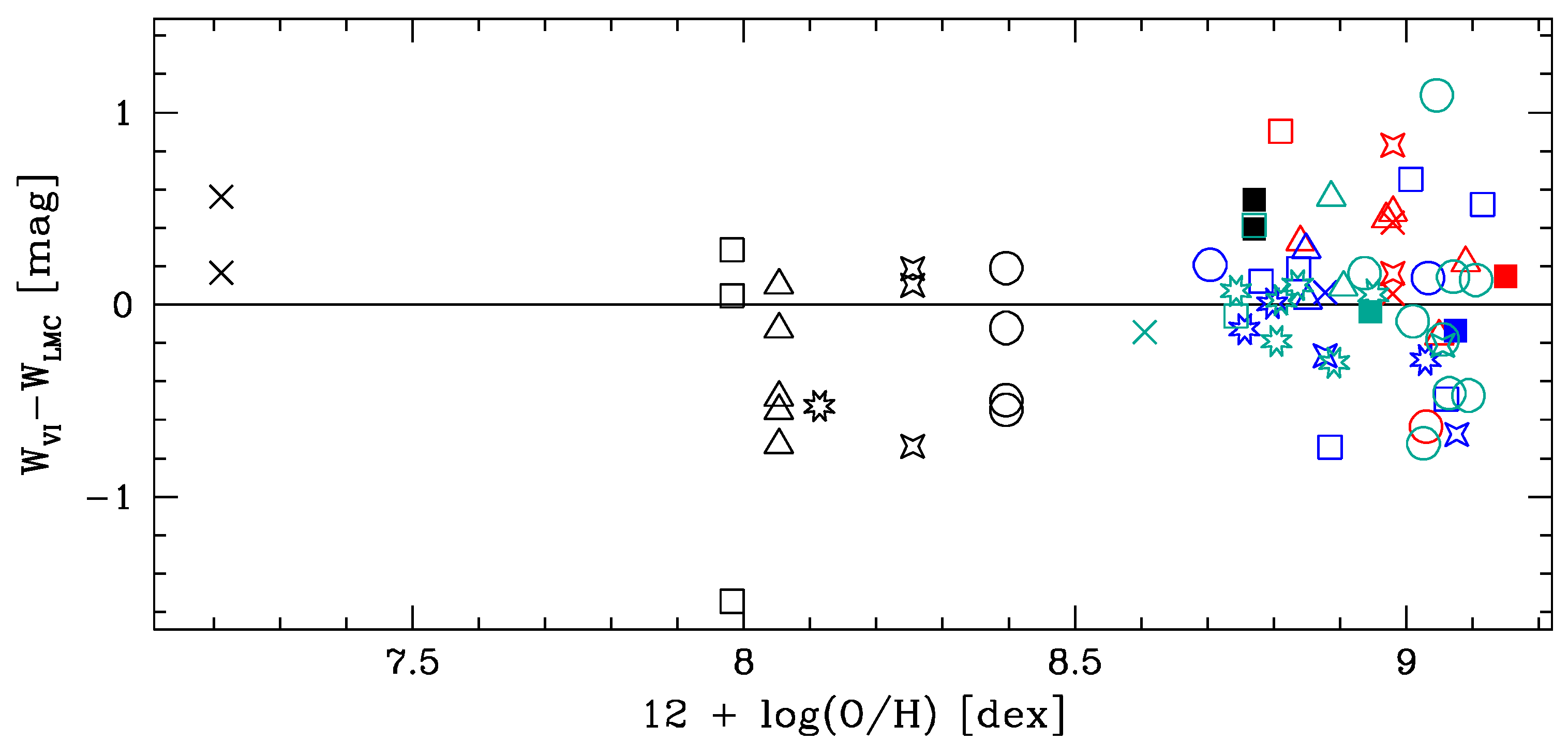
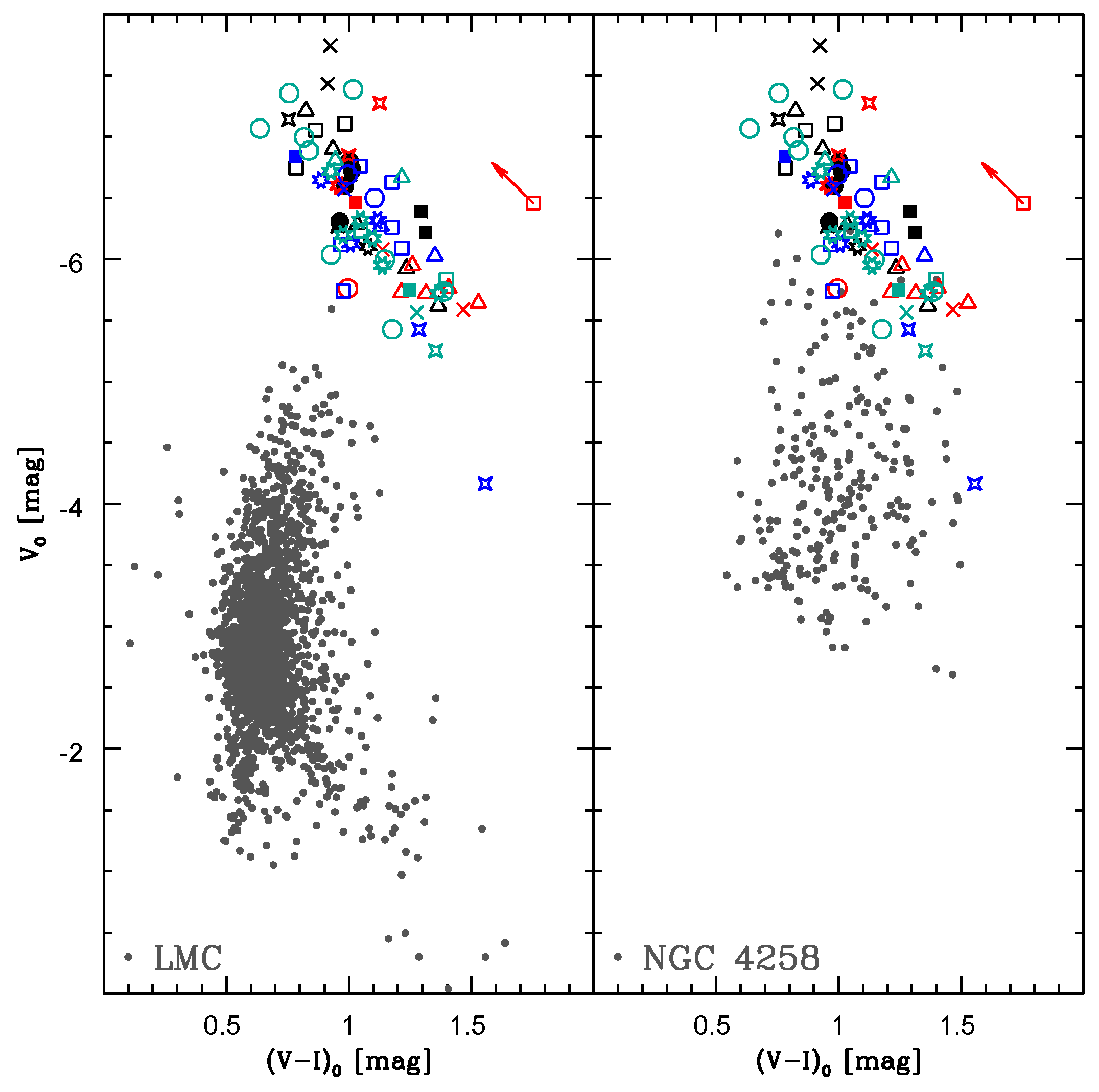
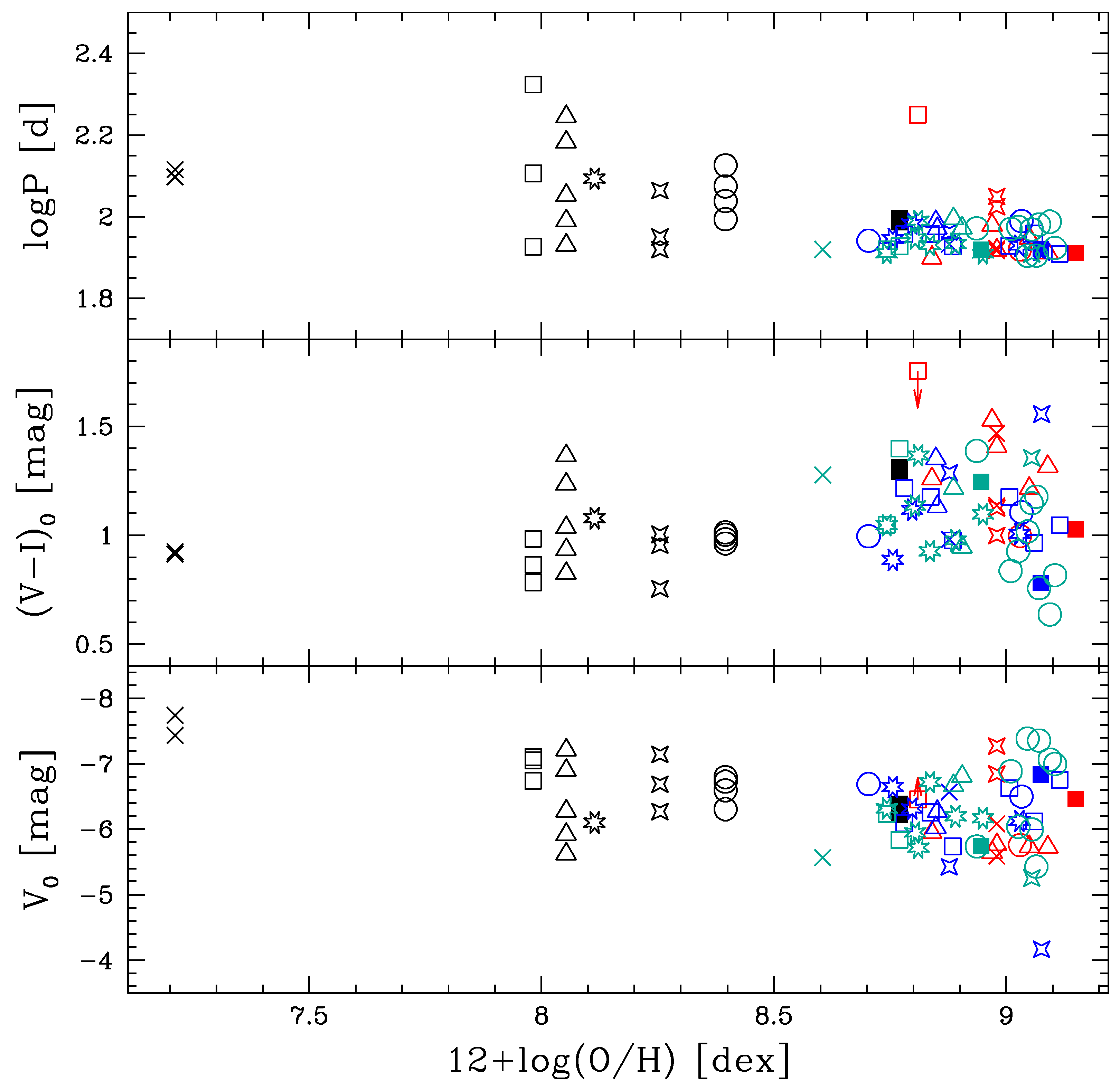
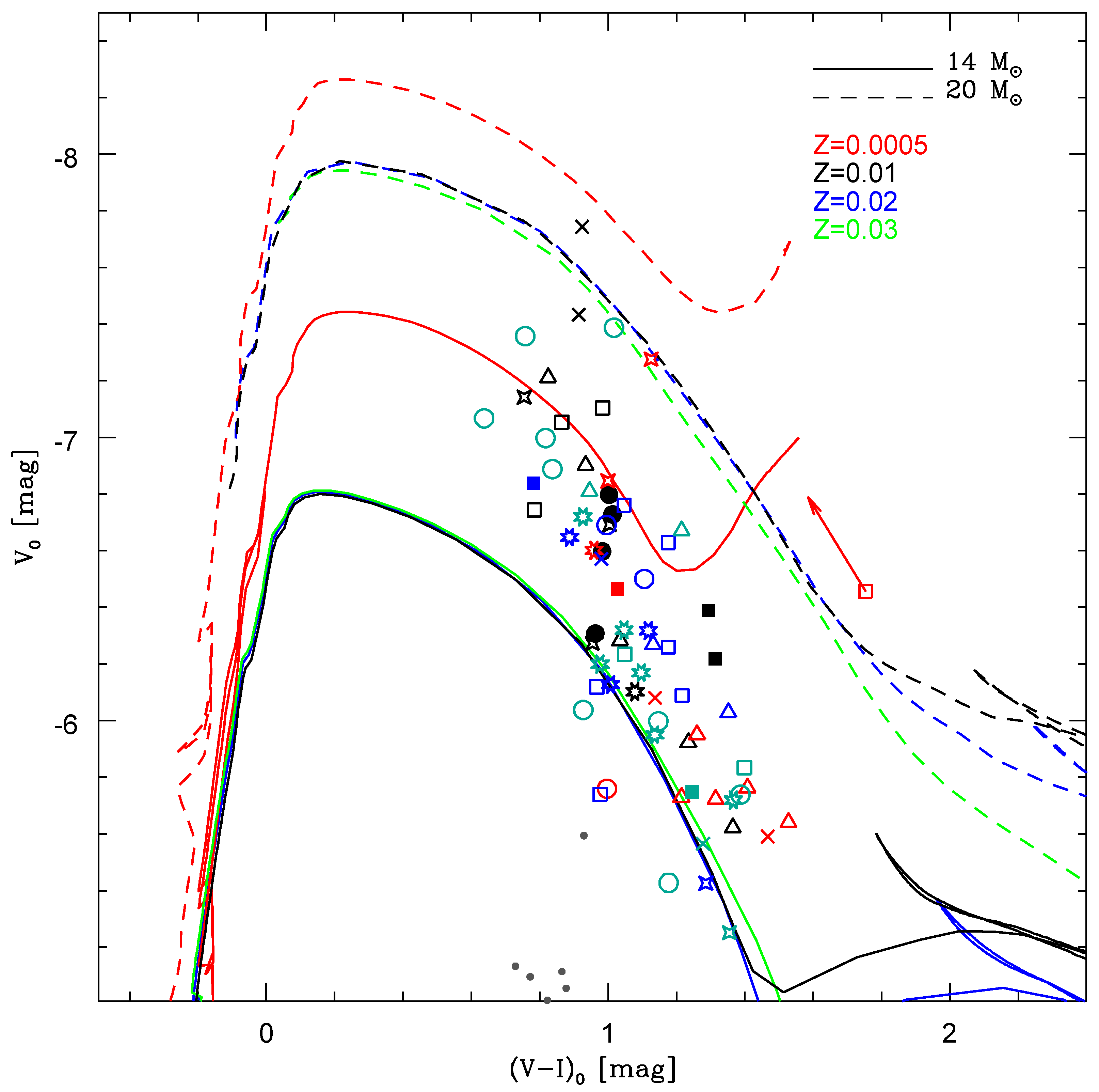
| Galaxy | Period | V | I | Z | ||||
|---|---|---|---|---|---|---|---|---|
| (d) | (mag) | (mag) | (mag) | (mag) | (mag) | (dex) | ||
| Bird Sample | ||||||||
| LMC | 118.7 | 11.99 | 10.87 | 9.13 | 18.50 | 0.07 | 8.396 | ∼0.008 |
| LMC | 109.2 | 12.41 | 11.34 | 9.68 | 18.50 | 0.07 | 8.396 | ∼0.008 |
| LMC | 98.6 | 11.92 | 10.81 | 9.09 | 18.50 | 0.07 | 8.396 | ∼0.008 |
| LMC | 133.6 | 12.12 | 11.03 | 9.34 | 18.50 | 0.07 | 8.396 | ∼0.008 |
| SMC | 210.4 | 12.28 | 11.45 | 10.16 | 18.93 | 0.03 | 7.982 | ∼0.002 |
| SMC | 127.5 | 11.92 | 10.89 | 9.29 | 18.93 | 0.03 | 7.982 | ∼0.002 |
| SMC | 84.4 | 11.97 | 11.06 | 9.65 | 18.93 | 0.03 | 7.982 | ∼0.002 |
| NGC55 | 175.9 | 19.25 | 18.41 | 17.11 | 26.43 | 0.01 | 8.053 | ∼0.003 |
| NGC55 | 152.1 | 19.56 | 18.61 | 17.14 | 26.43 | 0.01 | 8.053 | ∼0.003 |
| NGC55 | 112.7 | 20.18 | 19.13 | 17.50 | 26.43 | 0.01 | 8.053 | ∼0.003 |
| NGC55 | 97.7 | 20.54 | 19.29 | 17.35 | 26.43 | 0.01 | 8.053 | ∼0.003 |
| NGC55 | 85.1 | 20.84 | 19.46 | 17.32 | 26.43 | 0.01 | 8.053 | ∼0.003 |
| NGC300 | 115.8 | 20.13 | 19.16 | 17.66 | 26.37 | 0.01 | 8.255 | ∼0.004 |
| NGC300 | 89.1 | 19.71 | 18.69 | 17.11 | 26.37 | 0.01 | 8.255 | ∼0.004 |
| NGC300 | 83.0 | 19.26 | 18.49 | 17.30 | 26.37 | 0.01 | 8.255 | ∼0.004 |
| NGC6822 | 123.9 | 17.86 | 16.46 | 14.29 | 23.31 | 0.21 | 8.114 | ∼0.003 |
| IZw18 | 130.3 | 23.96 | 23.00 | 21.51 | 31.3 | 0.03 | 7.211 | ∼0.0004 |
| IZw18 | 125.0 | 23.65 | 22.68 | 21.18 | 31.3 | 0.03 | 7.211 | ∼0.0004 |
| M81 ULPs | ||||||||
| M81 | 96.8 | 21.52 | 20.12 | 17.95 | 27.69 | 0.07 | 8.77 | ∼0.013 |
| M81 | 98.98 | 21.69 | 20.27 | 18.07 | 27.69 | 0.07 | 8.77 | ∼0.013 |
| M31_N ULP | ||||||||
| M31 | 83.18 | 18.86 | 17.78 | 16.12 | 24.46 | 0.05 | 9.03 | ∼0.02 |
| M31_T ULP | ||||||||
| M31 | 177.32 | 18.16 | 16.33 | 13.49 | 24.46 | 0.05 | 8.81 | ∼0.01 |
| M31_K ULPs | ||||||||
| M31 | 79.35 | 18.79 | 1.398 | 15.22 | 24.46 | 0.05 | 8.84 | ∼0.01 |
| M31 | 81.35 | 19.08 | 1.483 | 15.30 | 24.46 | 0.05 | 9.09 | ∼0.02 |
| M31 | 82.74 | 19.07 | 1.591 | 15.01 | 24.46 | 0.05 | 8.98 | ∼0.02 |
| M31 | 88.45 | 19.01 | 1.352 | 15.56 | 24.46 | 0.05 | 9.05 | ∼0.02 |
| M31 | 95.377 | 19.13 | 1.681 | 14.84 | 24.46 | 0.05 | 8.97 | ∼0.02 |
| M33 ULPs | ||||||||
| M33 | 105.800 | 18.255 | 1.168 | 15.28 | 24.76 | 0.11 | 8.396 | ∼0.008 |
| M33 | 111.975 | 17.826 | 1.294 | 14.53 | 24.76 | 0.11 | 8.396 | ∼0.008 |
| NGC 4151 ULP | ||||||||
| NGC4151 | 82.608 | 24.619 | 1.072 | 21.89 | 30.99 | 0.074 | ||
| NGC6814 ULPs | ||||||||
| NGC6814 | 83.57 | 25.83 | 1.25 | 22.64 | 31.68 | 0.074 | 8.98 | ∼0.02 |
| NGC6814 | 82.47 | 26.32 | 1.58 | 22.29 | 31.68 | 0.074 | 8.98 | ∼0.02 |
| SH0ES sample | ||||||||
| M101 | 81.52 | 22.70 | 21.66 | 20.05 | 29.14 | 0.008 | 9.150 | 0.028 |
| NGC1015 | 87.33 | 25.90 | 24.86 | 23.25 | 32.50 | 0.029 | 8.704 | 0.010 |
| NGC1015 | 97.49 | 26.09 | 24.94 | 23.16 | 32.50 | 0.029 | 9.033 | 0.022 |
| NGC1309 | 80.89 | 25.87 | 24.77 | 23.06 | 32.52 | 0.035 | 9.115 | 0.026 |
| NGC1309 | 84.54 | 26.89 | 25.86 | 24.26 | 32.52 | 0.035 | 8.885 | 0.015 |
| NGC1309 | 84.89 | 26.00 | 24.77 | 22.86 | 32.52 | 0.035 | 9.007 | 0.020 |
| NGC1309 | 90.59 | 26.54 | 25.27 | 23.30 | 32.52 | 0.035 | 8.781 | 0.012 |
| NGC1309 | 90.71 | 26.37 | 25.14 | 23.23 | 32.52 | 0.035 | 8.838 | 0.014 |
| NGC1309 | 90.91 | 26.51 | 25.49 | 23.91 | 32.52 | 0.035 | 9.061 | 0.023 |
| NGC1448 | 93.35 | 25.08 | 23.93 | 22.15 | 31.31 | 0.012 | 8.852 | 0.014 |
| NGC1448 | 97.20 | 25.32 | 23.95 | 21.83 | 31.31 | 0.012 | 8.849 | 0.014 |
| NGC2442 | 81.84 | 27.90 | 26.07 | 23.23 | 31.51 | 0.179 | 9.076 | 0.024 |
| NGC2442 | 91.57 | 26.64 | 25.08 | 22.66 | 31.51 | 0.179 | 8.878 | 0.015 |
| NGC3370 | 84.92 | 26.03 | 24.98 | 23.35 | 32.07 | 0.028 | 9.029 | 0.021 |
| NGC3370 | 88.16 | 25.51 | 24.58 | 23.14 | 32.07 | 0.028 | 8.756 | 0.011 |
| NGC3370 | 96.10 | 25.84 | 24.68 | 22.88 | 32.07 | 0.028 | 8.798 | 0.013 |
| NGC3972 | 85.62 | 25.06 | 24.06 | 22.51 | 31.59 | 0.013 | 8.878 | 0.015 |
| NGC3982 | 83.30 | 24.94 | 24.14 | 22.90 | 31.74 | 0.012 | 9.074 | 0.024 |
| NGC4038 | 80.26 | 24.03 | 22.95 | 21.28 | 31.29 | 0.041 | 9.046 | 0.022 |
| NGC4038 | 80.27 | 25.99 | 24.75 | 22.83 | 31.29 | 0.041 | 9.065 | 0.023 |
| NGC4038 | 83.75 | 24.42 | 23.54 | 22.18 | 31.29 | 0.041 | 9.105 | 0.025 |
| NGC4038 | 93.07 | 25.42 | 24.21 | 22.33 | 31.29 | 0.041 | 9.055 | 0.023 |
| NGC4038 | 93.35 | 24.53 | 23.63 | 22.24 | 31.29 | 0.041 | 9.010 | 0.020 |
| NGC4038 | 93.57 | 25.68 | 24.23 | 21.98 | 31.29 | 0.041 | 8.937 | 0.017 |
| NGC4038 | 94.40 | 25.38 | 24.39 | 22.86 | 31.29 | 0.041 | 9.026 | 0.021 |
| NGC4038 | 95.64 | 24.06 | 23.24 | 21.97 | 31.29 | 0.041 | 9.071 | 0.024 |
| NGC4038 | 97.11 | 24.35 | 23.65 | 22.57 | 31.29 | 0.041 | 9.094 | 0.025 |
| NGC4258 | 83.26 | 23.20 | 22.13 | 20.47 | 29.39 | 0.014 | 8.743 | 0.011 |
| NGC4258 | 84.62 | 23.60 | 22.18 | 19.98 | 29.39 | 0.014 | 8.770 | 0.012 |
| NGC4536 | 93.62 | 24.15 | 23.18 | 21.68 | 30.91 | 0.016 | 8.905 | 0.016 |
| NGC4536 | 98.77 | 24.29 | 23.05 | 21.13 | 30.91 | 0.016 | 8.887 | 0.015 |
| NGC4639 | 81.01 | 26.35 | 24.96 | 22.81 | 31.53 | 0.023 | 9.055 | 0.023 |
| NGC5584 | 81.20 | 25.73 | 24.58 | 22.80 | 31.79 | 0.035 | 8.950 | 0.018 |
| NGC5584 | 81.36 | 25.58 | 24.48 | 22.77 | 31.79 | 0.035 | 8.743 | 0.011 |
| NGC5584 | 85.11 | 25.18 | 24.20 | 22.68 | 31.79 | 0.035 | 8.836 | 0.014 |
| NGC5584 | 85.71 | 25.70 | 24.67 | 23.07 | 31.79 | 0.035 | 8.891 | 0.016 |
| NGC5584 | 88.51 | 25.95 | 24.76 | 22.92 | 31.79 | 0.035 | 8.804 | 0.013 |
| NGC5584 | 97.75 | 26.18 | 24.76 | 22.56 | 31.79 | 0.035 | 8.811 | 0.013 |
| NGC7250 | 83.10 | 25.96 | 24.67 | 22.67 | 31.50 | 0.136 | 8.605 | 0.008 |
| UGC9391 | 82.99 | 27.20 | 25.94 | 23.99 | 32.92 | 0.009 | 8.946 | 0.018 |
Publisher’s Note: MDPI stays neutral with regard to jurisdictional claims in published maps and institutional affiliations. |
© 2022 by the author. Licensee MDPI, Basel, Switzerland. This article is an open access article distributed under the terms and conditions of the Creative Commons Attribution (CC BY) license (https://creativecommons.org/licenses/by/4.0/).
Share and Cite
Musella, I. Ultra Long Period Cepheids: Observation and Theory. Universe 2022, 8, 335. https://doi.org/10.3390/universe8060335
Musella I. Ultra Long Period Cepheids: Observation and Theory. Universe. 2022; 8(6):335. https://doi.org/10.3390/universe8060335
Chicago/Turabian StyleMusella, Ilaria. 2022. "Ultra Long Period Cepheids: Observation and Theory" Universe 8, no. 6: 335. https://doi.org/10.3390/universe8060335
APA StyleMusella, I. (2022). Ultra Long Period Cepheids: Observation and Theory. Universe, 8(6), 335. https://doi.org/10.3390/universe8060335






